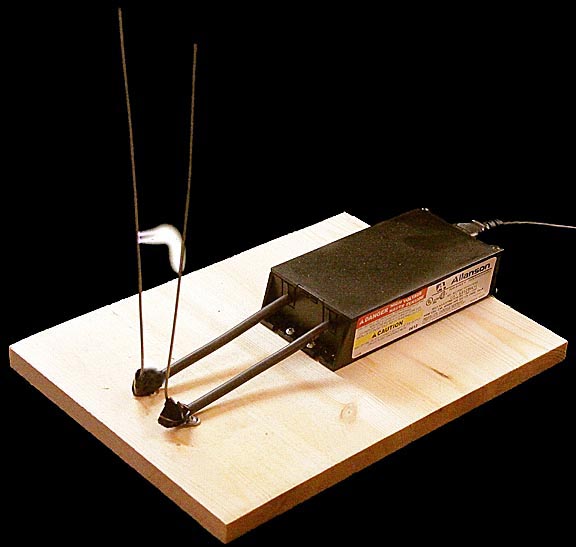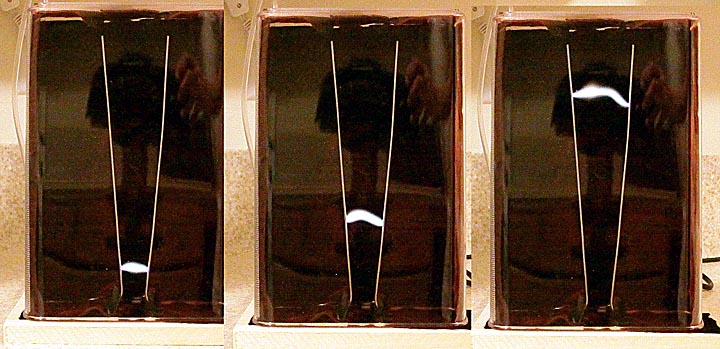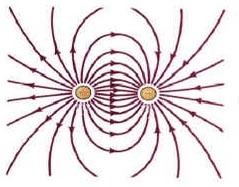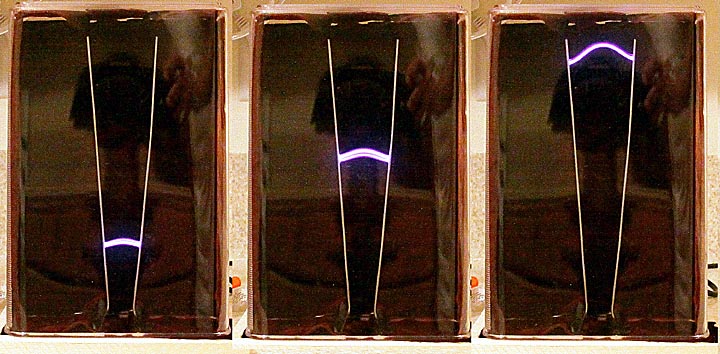

HOW TO BUILD A JACOB'S LADDER: All it takes is $120 and twenty minutes to build one of the most iconic electrical special effects devices of all time.

Popular in science fiction movies from the 1920s through the 1950s, the simple Jacob's Ladder creates an electric arc that slowly climbs a pair of angled electrodes. All you need to build one is a 12 x 18 inch wood board that's 1 inch thick, two copper or brass rods 1/8 inch in diameter, a 12,000 volt neon power supply (such as an Allanson Pow-R-Pack available from Amazon.com for $110), a few screws and electrical tape. Mount the power supply on the board with screws. cut the two leads 5 inches long and strip off the last inch of insulation from each lead. Bend a small loop in the end of each rod, shape the lower inch extending from the loop into a gentle arc and use screws to attach the rods to the board. You want the screws about 1 and 1/4 inches apart. By rotating the rods around the screws the distance between the curved lower sections of the rods can be adjusted. Wind the power supply wires around the bottoms of the electrodes and insulate them with electrical tape. Adjust the spacing so the bottoms of the electrodes are 3/4 inch apart. Being careful to keep the rest of the robs straight, bend them so their tops are 2 and 1/4 inches apart. You now have a working Jabob's ladder. But...
...the high voltage, current and frequency of this Jacob's Ladder's discharge can be lethal. It can start fires and fatally disrupt heart function. Never operate one alone. Never operate one without knowledgeable, adult supervision. Never touch any part of the device in any way when it is plugged in, even if it's turned off and an arc is not visible. When not in use, always keep it secured where children can't get to it.
For my Jacob's Ladder I've taken the added precaution of enclosing the discharge with a transparent plastic box, in this case a flour canister. It also provided a surface on which to mount a piece of black velvet as a dark background to make the arc appear brighter. The rest of the images on this page were taken with the protective plastic box in place.
A plastic enclosure stabilizes the arc, I believe because it prevents air currents from blowing it sideways and captures some of the ozone produced by the arc. Ozone increases the conductivity of air.
Humidity, air pressure and temperature can affect the arc. If your Jacob's Ladder fails to strike an arc, rotate the electrodes around their mounting screws so the distance between their closest spacing is reduced. If the arc strikes but doesn't climb, increase the closest spacing.
If the electrodes are too parallel, the arc may stick part way up. In that case bend them away from each other to increase the angle. If the arc breaks half way up, bend the electrodes inward to reduce the angle so it climbs all the way to the top.
After some use, you may notice that the black velvet lining the box is turning reddish brown. I believe this is a bleaching effect caused by the ozone, ultraviolet radiation from the arc, or both.
The electrodes on this Jacob's Ladder are 10 inches tall. An arc is struck and rises to the top every second. I've experimented with various electrode angles and could not find an angle that slowed the arc's climb. Increasing the angle between the electrodes causes the arc to break before reaching the top and a new arc to be struck at a much faster rate. Reducing the angle many times caused the arc to climb to the top and stick there, the sharp corners at the top of the electrodes acting as anchors. The only way to increase the time between each arc is to make the electrodes longer.
How
A Jacob's Ladder Works:

The neon power supply is essentially a transformer. When plugged into a wall socket it converts the 120-volt, 3.5 amp, 60 Hz input into a 12,000 volt, 35 milliamp, 60 Hz output.
At the bottom of the electrodes, where they are the closest, the electric field is strong enough to ionize air, changing it from an insulator to a conductor. The air in the arc is heated to many thousands of degrees. Because the air in the arc is hot it tends to rise, carrying the arc with it. Placed on it's side, so the electrodes are horizontal, the arc doesn't move along them.
Science students may wonder how a 12,000 volt power supply can strike an arc across a 3/4 inch gap when the dielectric constant for air suggests 60,000 volts is required. The answer is that the 60,000 volts required to create an arc across 3/4-inch is for a pair of parallel plates as in the following drawing:

The field lines are evenly spaced. Apply 12,000 volts across such an electrode configuration and it won't arc. But, in a Jacob's Ladder the electrodes are wires with small diameters. This causes the field to be nonuniform, with the area between the wires having a concentrated field many times greater than the applied voltage.

This concentrated field is what enables a Jacob's Ladder to create an arc. Once it's created, the conductivity of the ionized air is high enough to easily allow the arc to stretch to greater lengths as it climbs the ladder.
Besides making a Jacob's Ladder safer, a plastic enclosure also enables different gases to be introduced so see what effect they have on the arc. In the following image the chamber was flooded with helium from a disposable helium tank purchased from a party supply store for inflating balloons:

Air (mostly nitrogen and oxygen) produces a more diffuse, pale yellow discharge. Helium produces an violet arc that is much narrower. The middle image shows a double arc. This is caused by the alternating current from the power supply. Other gases would produce different colors. Neon sign stores may provide a source for them.
Jacob's Ladders can cause electrical interference so it's unwise to run them for any period of time. Letting one run for more than a few minutes can also heat the electrodes to dangerous temperatures.
Jacob's Ladders are interesting devices for science demonstrations, but are also extremely dangerous. Anyone building one is responsible for taking all the precautions necessary to ensure the safety of everyone and their property.
(Click
on main site
to browse 100 other topics ranging from exotic kaleidoscope designs
to the strange world of lucid dreaming.)